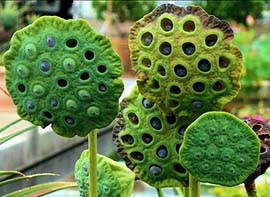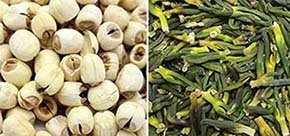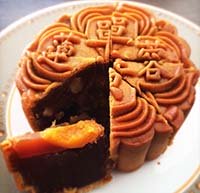Lotus seeds Nutrition facts
Lotus seeds are edible kernels of the lotus plant. The seeds are enclosed inside the "water can spout-like" fruit pod, arranged in a concentric fashion.
Lotus is a herbaceous perennial, belonging to Nelumbonaceae family of aquatic plants.
Scientific name: Nelumbo nucifera.
Since ancient times, lotus flowers, roots, and seeds esteemed in the Chinese and Japanese cultures. The seeds, however, symbolize the complete representation of all the four cardinal elements of nature; earth, water, air, and heat.

|
| Lotus fruit pod. Note for the raw seeds enclosed inside polygonal pits. Photo courtesy: Raymond Bucko. |
Lotus seeds and roots are major crops in Hubei, Hunan, Fujian, and Jiangxi provinces. Although perennial, the lotus plant flowers each year completing the cycle from dormant, root eruption, flowers, and seeds and again assuming a dormant state again during winter. Its roots and stem grow under the water, while its large green leaf pads and flowers float on the water's surface. Lotus buds begin blooming onto flowers by summer.
The flowers are white to pink, sweet-scented, 10-25 cm in diameter, and attract many insects including honeybees. Round, disc-like soft fruit pods develop from fertilized flowers. Each soft pad consists of polygonal pits encasing ovoid seeds.
Mature lotus seeds are black, ovoid, possess a hard outer shell, and measure about the size of a green pea. Inside, the dicotyledon kernel is creamy-white with a light green plumule in between the cotyledons. Fresh, raw lotus kernel has a sweet chewy texture and tastes like that of green almonds. Dried seeds have a taste similar to chickpeas.
Lotus plumule (Lian zi xin)
 |
| Dried Lotus kernels and green embryos (Lian zi xin) |
Inside each lotus kernel, a light green plumule exists in between the two cotyledons. This lotus plumule is the embryonic shoot of the lotus plant. Botanical name: Plumula Nelumbinis Nuciferae. The plumule consists of two prominent inrolled leaves with the attendant stem. Farmers separate these embryos from the kernel by gently pulling them up using their fingers. These plumules are dried in the sun to use in medicines and tea (lian xin cha).
Health benefits of Lotus seeds
Raw, fresh lotus seeds are sweet and chewy, while dry seeds are crunchy, and delicious only after baking. Fresh raw seeds carry just 89 calories per 100 g; while dry kernels hold 324 calories per 100 g.
Lotus seed's energy chiefly comes from carbohydrates and proteins unlike as in other tree nuts whose high calorific value is mainly because of fats.
The seeds are also packed with fiber, vitamins, minerals, and numerous health-promoting antioxidants.
Dry lotus seeds contain 15.4 g or 27% daily required levels of protein. Phenylalanine, tyrosine, leucine, and lysine were the essential amino acids in them. Studies revealed that the lotus seed protein is a nutritionally well-balanced protein and might be of significant importance in the formulation of diets for humans.
Like other dicotyledonous plant seeds, lotus seeds are free from gluten protein. They can be safely used in gluten-free food preparations as a healthy alternative in patients with wheat gluten allergy, and celiac disease.
Fresh as well as dry lotus kernels are an excellent source of folates. 100 g seeds provide 104 μg or 26% of folates. Folate along with vitamin B-12 is one of the essential components of DNA synthesis and cell division. Adequate folate diet during pregnancy may help prevent neural tube defects in newborns.
Lotus kernels are also an excellent source of the B-complex group of vitamins such as thiamin (53% of RDA/100 g), riboflavin (11.5% of RDA/100 g), niacin, pantothenic acid and vitamin B-6 (48% of RDA//100 g). These vitamins work as cofactors for various enzymes during cellular substrate metabolism in the human body.
Moreover, the seeds contain excellent amounts of minerals like manganese (100% of RDA//100 g), potassium (29% of RDA/100 g), calcium, iron (44% of RDA//100 g), magnesium, zinc and selenium. Manganese is an all-important co-factor for antioxidant enzyme, superoxide dismutase. Together with other antioxidants like vitamin A, consumption of lotus kernels may help boost immunity to fight against infectious agents and scavenge harmful oxygen-free radicals.
Medicinal values of lotus seeds.
In traditional Chinese medicine (TCM), lotus seeds and plumule occupy special therapeutic importance. Research studies suggest that alkaloids in lotus plumule like liensiline, neferine, and isoliensiline are sedative, antispasmodic, and antihypertensive which is beneficial to the heart.
TCM recognises lotus seed as a yin energy food. It dispels excess heat from the heart and spontaneous bleeding episodes due to heat.
According to TCM lotus seed falls in the category of "sweet flavor" food. The alkaloid compounds actually slow down acute reactions neutralize the toxic effects of other foods, and also lubricate and nourish the body.
In the TCM, lotus plumule has been advocated for sleep promotion, and to ease conditions associated with seminal and vaginal discharge.
| Principle | Nutrient Value | Percent of RDA |
|---|---|---|
| Energy | 332 Kcal | 17% |
| Carbohydrates | 64.47 g | 49% |
| Protein | 15.41 g | 27% |
| Total Fat | 1.97 g | 10% |
| Cholesterol | 0 mg | 0% |
| Vitamins | ||
| Folates | 104 μg | 26% |
| Niacin | 1.60 mg | 10% |
| Pantothenic acid | 0.851 mg | 17% |
| Pyridoxine | 0.629 mg | 48% |
| Riboflavin | 0.150 mg | 11.5% |
| Thiamin | 0.640 mg | 53% |
| Vitamin A | 50 IU | 1.66% |
| Vitamin C | 0 μg | 0% |
| Electrolytes | ||
| Sodium | 5 mg | <1% |
| Potassium | 1368 mg | 29% |
| Minerals | ||
| Calcium | 163 mg | 16% |
| Copper | 0.350 mg | 39% |
| Iron | 3.53 mg | 44% |
| Magnesium | 210 mg | 52% |
| Manganese | 2.318 mg | 100% |
| Phosphorus | 626 mg | 89% |
| Zinc | 1.05 mg | 9.5% |
Selection and storage
The green embryos (lotus plumule) in the seeds are bitter and should be removed prior to selling in the markets as food products. Raw, fresh lotus kernels can be readily available during the harvest season in the local markets around Great Lake counties in Hunan, Fujian, Hubei, and Jiangxi provinces in China. However, dry seeds can be readily sold in stores around many parts of the world, including the USA. One may find whole seeds, popped, hulled, roasted, etc., put for sale in the grocery stores.
While buying hulled, whole dry seeds choose uniform, compact, cream-white seeds that feel heavy in hand.
Avoid thin, small-sized, shriveled seeds as they yield poor-quality kernels. They should be free from cracks, mold, and spots and free of rancid smell.
Whole black seeds with hard coats keep well for many years. Hulled lotus kernels should be placed in an air-tight container and stored in a cool, dry place.
Culinary uses
 |
| Mid-autumn festival lotus seed paste cake Photo courtesy: Ash chuan. |
Fresh as well as dried lotus seeds can be eaten raw and cooked. Dry seeds soaked in hot water to soften, like red beans before using them in cooking. The seeds can be ground into powder, used in bread making, and popped like popcorn.
Here are some serving tips:
Fresh, raw kernels can be enjoyed as a healthy snack.
Lotus seeds paste is a prized ingredient in the preparation of Mid-Autumn Festival- moon cake (yue bing).
Baked lotus seed soup (Lian Chee Suan) is a delicious recipe in the southern China.
Pureed lotus seeds can be added to congee (porridge) as a healthy breakfast.
In India and Pakistan, lotus seeds are popular as phool makhana. The popcorned lotus seeds are added to kheer (sweet porridge), curry, and stew (sabzi) with other complimenting vegetables (aloo-makhana).
Lotus plumule infusion (Lian zi xin cha) is a healthy herbal tea drink.
Safety profile
Lotus seeds contain green embryos (plumule) in between the cotyledons. These plumules carry bitter alkaloids and should be removed before consumption.
Lotus Plumules, on the other hand, are used limitedly as a healthy herbal tea. Embryo-treated seeds are safe for pregnant women. (Medical disclaimer).
≻≻-You may also like to read Lotus root nutrition facts and Health benefits.
≻≻-Back to Nuts and Seeds from Lotus seeds nutrition. Visit here for an impressive list of nuts with complete illustrations of their nutrition facts and health benefits.
≻≻-Back to Home page.
Further Resources:
Stanford School of Medicine Cancer information Page- Nutrition to Reduce Cancer Risk.
Amino acid profiles and quality from lotus seed proteins. J. Sci. Food Agric., 93: 1070–1075. doi:10.1002/jsfa.5848
PubMed-active principles in lotus plumule.